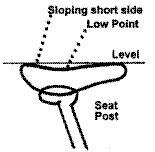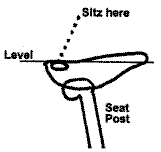Sitting on a bicycle saddle for more than a few minutes let alone for hours,
can be torture for new and veteran bicyclists alike. Just the thought is often a big
turn-off for many would-be bicyclists. Saddle comfort varies from brand to brand,and
since women's "perch bones" or "sitz bones" are farther apart than men's, women
should consider a saddle designed to accommodate the female anatomy. This Notebook
provides step by step saddle adjustments which can improve overall cycling comfort -
especially at this critical point of contact. The two keys to saddle comfort are:
where on the saddle your sitz bones are to be placed, and how to keep them (your keester)
planted there.
Frame Fit
Correct frame size is the first requirement for comfortable riding,
followed by proper adjustments to accommodate a comfortable posture. Visit your local bike shop
to make sure your bike is the correct size for you. If you have a doubt about the
advice you get, get a second opinion.
Height
Start by setting the saddle height to allow full leg extension with the
heel on the pedal at the bottom of the pedal stroke. Now slide the seat rails forward
or back so that the front knee is over the pedal spindle when cranks arehorizontal. This
fixes the knee, femur, and pelvis positions in proper relation to the bike frame and the
cranks. Bicycle fit professionals use a "FitKit" to scientifically determine these positions.
Some bicycle shops have this service available.

figure 1
Angle
Holding the saddle level, look at it from the side. Notice if there is a
'low point' .Figure 1.) If the shorter side is sloping, you will slide down and 'hang'
in the low point. Looking again at the saddle, tip the front (nose) up so that this short
side is level. This broad area of the saddle should be level when you sit on it, not the
overall saddle.(Figure 2.)

figure 2
Depending on your saddle, it may be necessary to tilt the nose of the saddle up -
no more than 5 degrees. Leveling this broad area prevents you from sliding forward.
It plants you firmly on the saddle and cradles you while riding. You may need to
lower the seat height slightly to compensate for this angle adjustment.
Bar Height
There are varying schools of thought on this, but I subscribe
to a more upright posture (back at 45 degrees) while on top of the bars (hands on the
highest part of the handlebar), achieved by raising the stem and/or rotating the handlebars
until the brake hoods are slightly upward. You loose slight aerodynamics, but you can
remedy this by dropping down to hold the lower ('drops') part of the handlebar when
necessary. You will also breath more easily, gaining oxygen capacity by not
compressing your lungs as you would when leaning over more.
This seat positioning will help alleviate pain in the hands and forearm caused
by continual pushing backward after sliding forward on an incorrectly adjusted
saddle. All in all, you'll feel more comfortable and have more fun!
Contributors to this article include ECIs Bill Moritz, Bud Melton, Jerry Hopfengardner,
Bill Hofrian, and John McClun.
Reprinted from "Bicycle USA", magazine of the League of American
Bicyclists, Nov/Dec 1996.
For more information about the League of American Bicyclists, visit
their web site, www.bikeleague.org,
or e-mail them at bikeleague@aol.com.
|